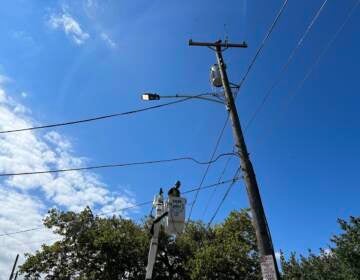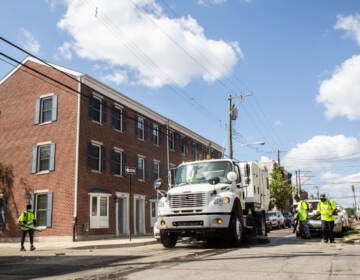Time’s a ticking on TIGER grant funded projects held up by American Street redesign

The clock is ticking on a project to transform North American Street in Kensington from a barren industrial roadway into a verdant, commercial avenue. If the city doesn’t meet rapidly approaching federal deadlines to begin work, the project might implode. If it does, it will take two other grant-funded projects down with it, costing Philadelphia $10.2 million in federal funds.
Back in October of 2015, Philadelphia won a federal Transportation Investment Generating Economic Recovery (TIGER) grant to fund three street improvement projects: A complete overhaul of North American Street between Girard and Lehigh avenues, the replacement of an abandoned swing bridge over the Schuylkill River into a pedestrian and bicycle bridge for the Schuylkill River Trail, and a small extension of West Westmoreland Street over a below-grade railroad crossing next to the Munoz-Marin Luis Elementary School.
TIGER grants require recipients to must have a contract signed for construction in place and ready to build within two years of the award, which means that the North American Street project needs a contract in place before the fall.
Everything is in place for the Schuylkill River Trail swing bridge and W. Westmoreland Street projects.
Before those projects can move forward, everything needs to be set for North American Street as well. That’s where things are coming down to the wire, as the final design for the street’s overhaul took much longer than Streets Department anticipated, thanks to significant blowback from the industrial businesses located on the street. Because they’re all part of the same grant award, if one of the projects doesn’t advance, none get to advance. That means the North American Street project needs to be under contract by the fall, but there are a number of preliminary milestones the project must hit as well.
First, the city needs to get PennDOT approval for changes to streets the state agency controls before June 30th—failure to do so could cost Philadelphia the federal grant, said Streets Department Chief Engineer Darin Gatti. In order to ensure that, the Streets Department needs to submit the plans to PennDOT in April. But before it can submit the plans, it will need Philadelphia’s City Council to sign off on North American Street’s redesign because it will replace a travel lane with a bicycle lane, which requires Council’s pre-approval per a 2012 law.
For City Council to sign off one of its members will need to introduce a bill to OK the street change. Rafael Álvarez, an aide to 7th District Councilwoman Maria Quiñones-Sánchez who represents the project area, told PlanPhilly last week that his boss was simply waiting for Streets to send over the bill. Ordinances to redesign streets are usually drafted by Streets Department staff, he said, due to their technical nature. According to Álvarez, Quiñones-Sánchez plans to introduce the bill once she gets it.
Once the bill is introduced it would need to be scheduled for a hearing before council’s Streets and Services Committee. Because the bill hasn’t been introduced yet, meaning it won’t make it onto the agenda for the committee’s next hearing on March 21st. The next meeting hasn’t been scheduled yet, but Sean McMonagle, a legislative assistant for Streets Committee chair Councilman Mark Squilla, said he expects it will be “probably towards the end of the month.”
The Streets committee could schedule an earlier hearing if need be, which looks likely if Streets Department needs to submit its plans by the end of April. After the committee hearing, the bill would still need to return to City Council for a vote of the whole chamber, which only meets on Thursdays.
Assuming the city meets the June 30th deadline, Streets should have ample time to bid out the construction contract before the late fall final grant deadline.
The lack of a bill coming relatively late in the process led to rumors that the project was doomed, done in by business interests along the street. Early on, the industrial businesses located along this stretch of North American Street took issue with the proposed redesign, which called for bike lanes, street trees, and the replacement of old rail tracks down the street’s median with “bioswale”, or a sloping landscaped strip to absorb stormwater.
The proposal seemed to put North American Street’s southern end, which has become more residential in recent years, on a collision course with the street’s northern end, which remains dominated by industrial uses, many of which were encouraged by the city’s Commerce Department. American Street has been a focus of industrial development plans since at least the 1980s when it was designated an Enterprise Zone, and saw renewed attention during the early days of Mayor John Street’s Neighborhood Transformation Initiative.
According to Gatti, the conflicts have all been settled. “We tried to find the happy medium there where everyone gets a benefit,” said Gatti.
The latest design is less ambitious than the original in some ways. The stormwater infrastructure will still run the entire length of the street, but at some sections it will only run underground. The green, landscaped infrastructure above ground will periodically give way to pavement to allow trucks in and out of the factories and warehouses along the street with relative ease. Streets’ engineering team also moved the bike lanes to the center of the street, next to the green stormwater ditch. Gatti said the center bike lanes would reduce conflict points with trucks and cars.*
The bike lane will be a raised lane with a sloping curb—the first such protected bike lane in the city. It will be six and a half feet wide, with a one and a half-foot-wide buffer curb.
If all goes according to plan, a construction contract will be signed in the late summer or early fall, meaning the city will get to use its TIGER grant for this and two other projects. The earlier delays mean there’s no room for any more holdups, though.
Gatti said construction is likely to begin early in 2018 and should last about two years.
*CORRECTION: This paragraph was updated to clarify that the stormwater management infrastructure would run the entire length of the street’s median, even in sections where there won’t be some of the visible, planted elements.
WHYY is your source for fact-based, in-depth journalism and information. As a nonprofit organization, we rely on financial support from readers like you. Please give today.






